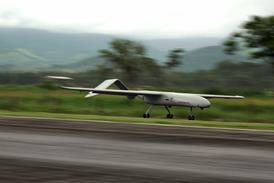Alenia Aeronautica's heavy investment in its factory that supplies the Boeing 787 programme reflects an expectation of 30 to 40 years of revenue
The first, overriding impression formed on any visit to Alenia Aeronautica's Boeing 787 fuselage barrel factory at Grottaglie is that it is big. Purpose-built to supply the Dreamliner with centre fuselage sections 44 and 46, the facility takes in nearly 497,000m² (5.35 million ft²), including 109,000m² under cover.
There is a staggering 175,000m² of clean room space and automated machinery big enough to manipulate the carbonfibre barrels in their entirety, moving them around the reinforced factory floor on self-propelled dollies between work stations, from fibre laying to autoclave, to cutting, drilling, assembly and shipping.
Alenia says the plant employs 792 staff. When Flightglobal visited, nothing like the full complement could have been on site, but if Alenia had insisted that, indeed, the whole team was on hand, it would have been hard to dispute; this cavernous space could probably accommodate 10 times that many without crowding.
The impression, too, is of an industrial process devised by Hollywood's most unrestrained imaginations to portray a James Bond villain's mad scheme for global domination. To look at the immense machines built for this project, one would almost believe they were designed by Dr Seuss, such is the fantastic nature of the lifting, shifting, rotating, reaching and pushing together of enormous, complicated shapes.
Plant manager Fernando DeMaria says Alenia's process is not like any of the other Boeing partners. Speaking as the first 787 was being delivered to All Nippon Airways in October, DeMaria said the plant was taking a week to make a fuselage barrel, down from a month earlier in the programme. His job during the next couple of years will be to ramp-up Alenia's unique process to achieve the 10 a month rate Boeing hopes to reach in final assembly by the end of 2013.
What makes it financially possible to invest so much in a unique production scheme is the fact this project has a 30 to 40-year life. And, as DeMaria notes, the Grottaglie plant is big enough to expand beyond 10 a month, or into other Boeing projects. If the building ever proves too small, he notes, Alenia owns all the adjacent land.
However, for all its vast size and mechanical and computerised complexity, the human scale of this operation cannot be ignored. Donato Amaroso, Alenia's co-chief operating officer for production, stresses that the process is, in fact, a delicate combination of automation and handcraftsmanship, which is greatly helped by the fact Alenia has been able to assemble a young workforce, many recruited from the local area.
"Aerospace," Amaroso says, "is wonderful work. Without passion you don't go anywhere."
Source: Flight International























